Zika virus belongs to the family Flaviviridae and belongs to the genus Flavivirus. It is transmitted by the Aedes species of mosquito, which is active during the day time.
This virus is known to cause a very mild illness in human body, known as zika fever. This disease used to occur in the equatorial region between Africa and Asia. Later, it started spreading to the eastern nations and a zika breakout occurred.
This virus is related to the viruses causing dengue and yellow fever. The illness is similar to that of dengue fever, but in a much milder form. This type of illness is also treated by rest, as in case of dengue fever. Researchers have shown some link between Microcephaly in newborn babies and infection of mother with Zika virus. The Centre for Disease Control and Prevention (CDC) has issued some precaution guidelines for pregnant women who travel from the affected country to at least 22 nations, mostly Latin America and the Caribbean Islands. This also includes postponement of traveling for at least eight months.
Zika Virus – Causes
Though Aedes mosquito is responsible for spreading the virus through the bite, there have been speculative reports that the disease has been spread through genetically modified Aedes mosquitoes developed by British firm Oxitech in 2012. They were released in the air in countries like Brazil, Malaysia, Cayman Islands and India to breed with buds and produce offspring that would die, reducing the incidence of malaria and dengue. The efforts to eradicate Aedes Aegypti species of mosquitoes have resulted in Zika, according to critics. Oxitech has denied the claim.
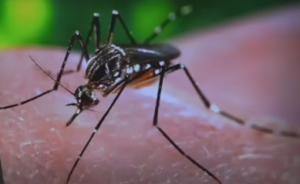
Structure
This virus is enveloped and icosahedral in structure. The nucleocapsid is surrounded by a bilayer of lipid, which is derived from the host membrane and is 25-30 nm in diameter. The envelope proteins are E and M. The virion is characterized by the presence of various surface projections which measure around 5-10 nm. The whole structure of virion has a diameter of about 40 nm.
Transmission
The mode of transmission is mainly due to mosquito bites. Rarely, the virus is transmitted from mother to child. The mosquito which spreads this virus is the Aedes species, which lays eggs and get multiplied in stagnant water. These mosquitoes bite infected people and get infected by the virus. Later, when this mosquito bites a healthy individual, it spreads the infection to the healthy individual.

If a pregnant mother is already affected with Zika Virus, she can spread this infection to her child through placenta. There is no evidence of spreading of this infection through breast feeding. It is so far considered safe if the mother is suffering from this virus and she breastfeeds her child. Because of the well known advantages of breast feeding, it is encouraged even if the mother is infected from Zika virus. The scare of Zika Virus is more to do with the fetus to develop birth defects like Microcephaly, and the fact that the disease is known to spread at a faster rate across countries.
This virus can also spread by blood transfusion and unsafe sexual contact.
Symptoms of Zika Virus
All the persons affected from this virus do not develop illness. It is known that only one in about 5 cases develops illness. The most common symptoms include joint pain, rashes and fever. Conjunctivitis can also occur, with muscle pain and headache. As stated earlier, the illness is very mild and the duration is about a few days to a week. The virus remains in the blood of the infected individual for a few days after disappearance of symptoms.
There are a very few evidences showing deaths due to this condition.
Diagnosis
The diagnosis of this condition is by proper history and blood examination. Your physician will suggest some blood tests like virus isolation and PCR (polymerase chain reaction) to detect the presence of this virus in your blood.
Zika Virus – Pictures
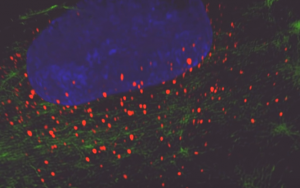

The University of Alberta showed how the Zika Virus in a human cell, with the help of a high resolution microscope. The red dots are the places where the virus replicates, the green areas are actin (protein that constitutes the filament of muscle cells and help in the movement of cells) and the blue structure is the nucleus.
Zika Virus – Treatment
There are no medications or vaccines available yet to prevent or treat Zika infections. However, the symptoms can be treated by taking various precautions and measures. You need to take plenty of rest. Use the same methods of prevention that you would to ward off a mosquito bite, like using an insect repellent, applying a mosquito spray, using nets and wear full clothes while sleeping etc. Also, ensure that you clear water from contains like flower pots, buckets etc so that mosquitoes do not breed in a stagnant environment.

Some medication like acetaminophen can help you in treating fever and pain. Any other medications of the non-steroidal anti-inflammatory drugs group should not be taken unless the condition is ruled out. As any such drugs can cause internal hemorrhage, they need to be avoided strictly.
Also if you are infected form the virus, you should avoid any mosquito bites in the first week of your illness as it can cause spread of the infection through mosquito bites.
Zika Virus – Countries Affected (Statistics and WHO Predictions)
Before 2015, the infection of this virus was seen only in a few nations including areas of Pacific islands, Southeast Asia and parts of Africa. In 2015, first evidence of the presence of this infection in Brazil was registered. More than 1. 5 million women in Brazil have a likelihood of being infected with close to 3900 suspected cases. El Salvador has asked women not to be pregnant till 2018. In the US, handful of cases have been reported and the mosquitoes that spread the virus are more common in the Southern US and Hawaii.
The CDC as on January 2016, said that pregnant women should not travel to 23 countries which include Brazil, El Salvador, Colombia, French Guiana, Haiti, Guatemala, Martinique, Honduras, Mexico, Panama, Suriname, Venezuela, Puerto Rico, Suriname, Saint Martin, Guyana, Cape Verde, Ecuador, Bolivia, Barbados and Samoa. The CDC recommends women returning from these areas to get tested for the presence of virus.

More than 22,000 people in Colombia have been affected by the Zika Virus. The WHO says that more than 4 million people in the world could be affected by the virus. It believes that with the rise in El Nino, the spike in cases of Zika Virus could be higher.
Zika vaccine
Zika is known to cause severe birth defects in babies whose mother are suffering from this infection. Several measures are being taken to develop a vaccine against this virus. It is estimated that by the end of this year, this virus can affect as much as 40 million people worldwide. Some of the leading vaccine maker companies have assured the attempts of developing a vaccine against this virus. For a vaccine to appear in the market, it has to go through a series of clinical trials to assure its safety and effectiveness. A vaccine against this virus can be expected soon. Read more about Microcephaly .
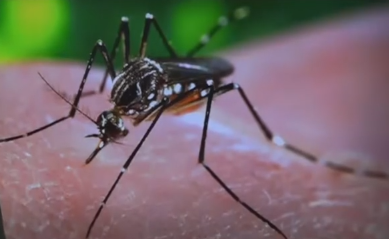
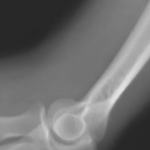
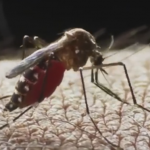
What can the symptons cause?